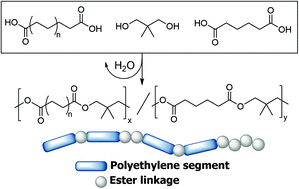Melt polycondensation of carboxytelechelic polyethylene for the design of degradable segmented copolyester polyolefins†
Abstract
Chain-transfer ring-opening metathesis polymerization (CT-ROMP) previously provided a route to carboxytelechelic polyethylene (PE) of controlled molecular weight; however, the incorporation of oligomeric PE into segmented copolymers remains unexplored. Herein, CT-ROMP afforded carboxytelechelic polycyclooctene segments, and subsequent reduction generated well-defined carboxytelechelic PE with Mn = 3900 g mol−1. Solvent-free melt polycondensation of neopentyl glycol and adipic acid with varying wt% telechelic PE oligomers yielded mechanically durable segmented copolyesters. The thermal and thermomechanical properties of the segmented copolyesters correlated with PE segment content, and high PE content copolymers exhibited remarkably similar morphologies and thermomechanical performance to conventional HDPE. The segmented copolyesters displayed advantageous physical properties while introducing susceptibility to chemo- and bio-catalytic depolymerization through periodic ester linkages, thus providing valuable fundamental understanding of an alternative route to HDPE.



 Please wait while we load your content...
Please wait while we load your content...